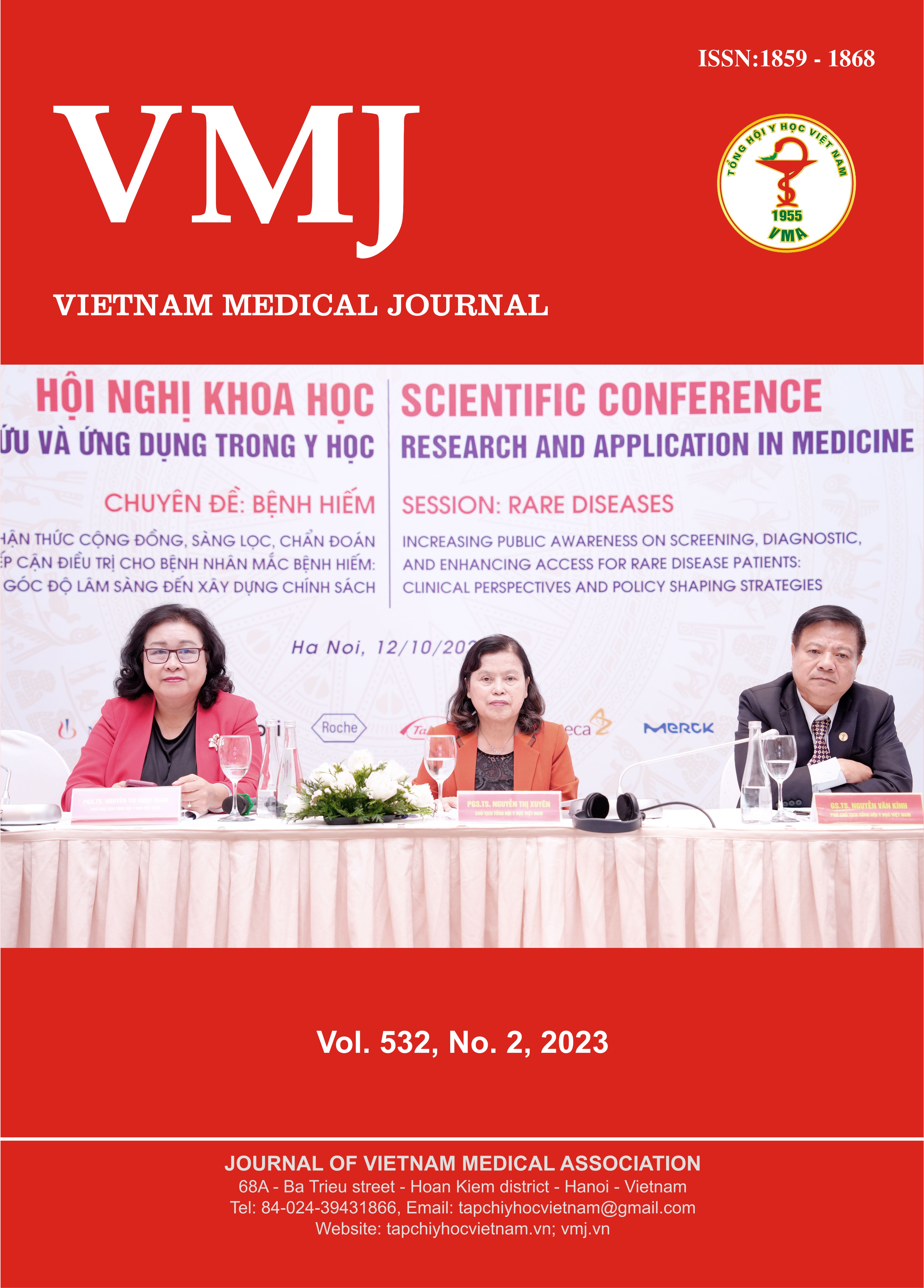NON-DIPPING BLOOD PRESSURE PATTERNS AND ASSOCIATED TARGET ORGAN DAMAGE IN ELDERLY HYPERTENSIVE PATIENTS
Nội dung chính của bài viết
Tóm tắt
Background: Older adults with hypertension face an increased risk of adverse cardiovascular outcomes, emphasizing the importance of target organ damage (TOD) in their treatment. The non-dipping blood pressure (BP) pattern, characterized by inadequate reduction of nocturnal BP (less than 10-20%), is associated with a higher likelihood of TOD in individuals with essential hypertension. This study aimed to examine the characteristics of non-dipping BP patterns among elderly individuals with essential hypertension and evaluate their associations with TOD. Methods: A descriptive cross-sectional study was conducted, involving 96 patients aged ≥60 years (mean age 70.9 ± 7.9 years, 35.4% male). Participants underwent routine clinical and laboratory assessments, including clinic and 24-hour ambulatory blood pressure monitoring. TOD was defined as the presence of left ventricular (LV) hypertrophy, renal impairment, or proteinuria. Results: Non-dipping patterns for systolic and diastolic BP were observed in 36 (36.5%) and 41 (42.7%) patients, respectively. TOD was present in 61 (63.5%) patients. Non-dipping systolic patients exhibited lower rates of diabetes mellitus (37.1% vs. 81.3%, p=0.006), dyslipidemia (68.6% vs. 100%, p=0.011), higher levels of creatinine (median 85.6, interquartile range [IQR] 72.1-101 vs. 70.8, IQR 62.4-78.3 µmol/l, p=0.012), and higher LV mass index (median 106.6, IQR 96.4-148.4 vs. 93.7, IQR 72.9-111.5 g/m2, p=0.028) compared to dipping patients. Non-dipping diastolic patients had a lower prevalence of dyslipidemia (73.2% vs. 100%, p=0.048) and a lower body mass index (median 23, IQR 19.73-25 vs. 25.26, IQR 22.54-27.17 kg/m2, p=0.013). Multivariate analysis, after adjusting for cardiovascular risk, showed that non-dipping patterns (both systolic and diastolic) were associated with TOD (odds ratio 7.21; 95% confidence interval 1.47-35.36, p=0.015). Conclusion. Our study underscores the significant association between non-dipping blood pressure patterns and TOD in elderly individuals with essential hypertension. The notable prevalence of non-dipping patterns emphasizes the clinical importance of monitoring and managing these patterns in clinical practice.
Chi tiết bài viết
Từ khóa
ambulatory blood pressure monitoring, blood pressure patterns, dipper, elderly, hypertension, non-dipper, target organ damage.
Tài liệu tham khảo
2. Leoncini G, Sacchi G, Viazzi F, et al (2002) Microalbuminuria identifies overall cardiovascular risk in essential hypertension: An artificial neural network-based approach. J Hypertens 20:1315–1321. https://doi.org/10.1097/00004872-200207000-00018
3. Ogden LG, He J, Lydick E, Whelton PK (2000) Long-term absolute benefit of lowering blood pressure in hypertensive patients according to the JNC VI risk stratification. Hypertension 35:539–543. https://doi.org/10.1161/01.HYP.35.2.539
4. Cuspidi C, Sala C, Tadic M, et al (2015) Non-Dipping Pattern and Subclinical Cardiac Damage in Untreated Hypertension: A Systematic Review and Meta-Analysis of Echocardiographic Studies. Am J Hypertens 28:1392–1402. https://doi.org/10.1093/ajh/hpv094
5. Okamoto LE, Gamboa A, Shibao C, et al (2009) Nocturnal blood pressure dipping in the hypertension of autonomic failure. Hypertension 53:363–369. https://doi.org/10.1161/HYPERTENSIONAHA.108.124552
6. Huynh VM, Tran VH, Pham GK, et al (2018) 2018 VNHA/VSH Guidelines for Diagnosis and Treatment of Hypertension in Adults. 1–53
7. Williams B, Mancia G, Spiering W, et al (2018) 2018 ESC / ESH Guidelines for the management of arterial hypertension The Task Force for the management of arterial hypertension of the European Society of Cardiology ( ESC ) and the European Society of. Eur Heart J 39:3021–3104. https://doi.org/10.1097/HJH.
8. World Health Organization. Regional Office for the Western Pacific (2000) The Asia-Pacific perspective: redefining obesity and its treatment. Sydney: Health Communications Australia
9. American Diabetes Association (2020) Classification and diagnosis of diabetes: Standards of Medical Care in Diabetes-2020. Diabetes Care 43:S14–S31. https://doi.org/10.2337/dc20-S002
10. Kavey REW, Daniels SR, Lauer RM, et al (2003) American Heart Association guidelines for primary prevention of atherosclerotic cardiovascular disease beginning in childhood. Circulation 107:1562–1566. https://doi.org/10.1161/01.CIR.0000061521.15730.6E
11. Lang RM, Badano LP, Mor-Avi V, et al (2015) Recommendations for cardiac chamber quantification by echocardiography in adults: An update from the American society of echocardiography and the European association of cardiovascular imaging. Eur Heart J Cardiovasc Imaging 16:233–271. https://doi.org/10.1093/ehjci/jev014
12. O’Brien E, Parati G, Stergiou G, et al (2013) European society of hypertension position paper on ambulatory blood pressure monitoring. J Hypertens 31:1731–1768. https://doi.org/10.1097/HJH.0b013e328363e964
13. Pierdomenico SD, Pierdomenico AM, Coccina F, et al (2017) Prognostic value of nondipping and morning surge in elderly treated hypertensive patients with controlled ambulatory blood pressure. Am J Hypertens 30:159–165. https://doi.org/10.1093/ajh/hpw145
14. Calvo C, Hermida RC, Ayala DE, et al (2004) Prevalence of non-dipper blood pressure pattern in elderly patients with essential hypertension as a function of circadian time of antihypertensive treatment. Am J Hypertens 17:43A–44A
15. Wang C, Deng WJ, Gong WY, et al (2015) Nocturnal Hypertension Correlates Better With Target Organ Damage in Patients With Chronic Kidney Disease than a Nondipping Pattern. J Clin Hypertens 17:792–801. https://doi.org/10.1111/jch.12589
16. Routledge FS, McFetridge-Durdle JA, Dean CR (2007) Night-time blood pressure patterns and target organ damage: A review. Can J Cardiol 23:132–138. https://doi.org/10.1016/S0828-282X(07)70733-X
17. Nakagawa N, Sato N (2023) Potential impact of non-dipping pulse rate pattern and nocturnal high pulse rate variability on target organ damage in patients with cardiovascular risk. Hypertens Res 1054–1055. https://doi.org/10.1038/s41440-023-01186-1
18. Cuspidi C, Sala C, Valerio C, et al (2012) Nocturnal hypertension and organ damage in dippers and nondippers. Am J Hypertens 25:869–875. https://doi.org/10.1038/ajh.2012.49
19. De La Sierra A, Redon J, Banegas JR, et al (2009) Prevalence and factors associated with circadian blood pressure patterns in hypertensive patients. Hypertension 53:466–472. https://doi.org/10.1161/HYPERTENSIONAHA.108.124008
20. Shlomai G, Grassi G, Grossman E, Mancia G (2013) Assessment of target organ damage in the evaluation and follow-up of hypertensive patients: Where do we stand? J Clin Hypertens 15:742–747. https://doi.org/10.1111/jch.12185


